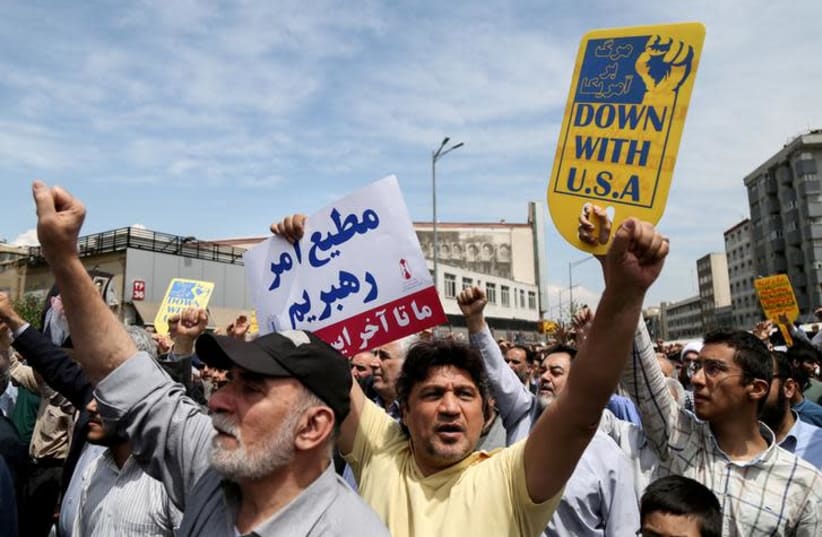This escalation in Trump’s hardened policy towards Tehran aims to cut Iranian crude exports completely, threatening the regime’s main source of revenue during its current deep recession.
These sanctions put additional pressure on Tehran after Washington’s pull out of the international nuclear deal with Iran last year.
America’s threat of sanctions against buyers of Iranian crude will remove roughly 2 million barrels of oil from the market per day, raising the price of crude and forcing some of Tehran’s largest clients to shop elsewhere for their energy needs. Among those clients will be Beijing. According to some estimates, US sanctions against Iranian oil will hasten inflation in China and contribute to a sharper slowdown of its economy, serving as untimely complications for Chinese policy makers during their ongoing trade tensions with Washington.
A nagging factor in these developments is the cost of crude. Oil prices are already at a six-month high, with US crude having risen 45% and Brent crude prices up by 38% in 2019 so far.
To address this, the Trump administration is in talks with Sunni Gulf allies about making up the shortfall in daily oil output. The White House has said that it is working with Saudi Arabia and the United Arab Emirates to certify that global crude demand is met “as all Iranian oil is removed from the market.” Saudi Energy Minister Khalid al-Falih has pledged that Riyadh will work with oil producers “to ensure adequate supplies are available to consumer.”
These complications aside, Trump’s Iran oil sanctions are necessary; gone are the days of Washington’s conciliatory ways toward Tehran. The president’s latest sanctions are part and parcel of his administration’s hardline Iran policy, which serves as a marked departure from years of US failure to respond to Iranian hostility against American interests.
In justifying Trump’s policy against Tehran, it bears reviewing the long litany of Iranian aggression against its neighbors and the US. The mullah regime’s crimes go back decades, starting with the separate US Embassy and Beirut barracks bombings of 1983, followed by the 1996 Kobar Towers bombing in Saudi Arabia.
Iran’s support of Shi’ite militias – which murdered hundreds of US military personnel with advanced IEDs in both Iraq and Afghanistan – is also well documented.
Beyond this, for over 30 years Iran has contributed to increased sectarianism in the Middle East while supporting terrorism through Hezbollah and Hamas. It has also exported its revolution through the radicalization of Shi’ite groups in the region, and has aggressively supported a state policy to destroy Israel.
Today, the reality is that Iran’s fingerprints can be found in Iraq, Syria, Lebanon, Bahrain, Yemen and Afghanistan – and even in the Shi’ite-majority Eastern Province of Saudi Arabia.
Since taking office, Trump’s outreach to Sunni Gulf states, Egypt and Israel – each of which felt abandoned under Obama – has galvanized effective push back against Tehran’s nefarious activities.
Still, in conjunction with oil sanctions, the Trump administration can build on this promising Iran-policy framework by focusing on a few additional key areas:
• Middle East states under assault by Iran’s proxies need continued American backing. Yemen is perhaps the most widely covered example, with the sitting Yemeni government and Saudi Arabia fighting against the Iran-funded Shi’ite Houthi rebels in their attempt to overthrow the government in Sanaa.
• Necessary investments must be made to ensure a net advantage of military and cyber capabilities over Tehran.
• Measures must be taken to work with local US partners to counter Tehran’s ambitions of securing the Shi’ite Crescent, a land bridge extending from Iran through Iraq and Syria to Lebanon and the Mediterranean. This path would give Iran continuity with its Arab proxies in Syria and Lebanon. This challenge demands both a continued military backing of friendly groups and a political strategy as to who governs where now that ISIS has fallen.
• Problems abound with the Iran nuclear agreement, known as the Joint Comprehensive Plan of Action (JCPOA), and Trump was right to withdraw from it last year. Washington and its allies must work with a sense of urgency to put an end to Tehran’s nuclear program, either by addressing the many inadequacies of the JCPOA or via any other means necessary.
As with all geopolitical challenges, coming events will dictate other necessary measures. Yet, these steps along with current Iranian oil sanctions can forge a strong, impactful Iran policy, further raise the costs of Iranian aggression and deter future misbehavior.
Ted Gover, PhD, writes on foreign policy and is the director of the Tribal Administration Program at Claremont Graduate University in Claremont, California.
